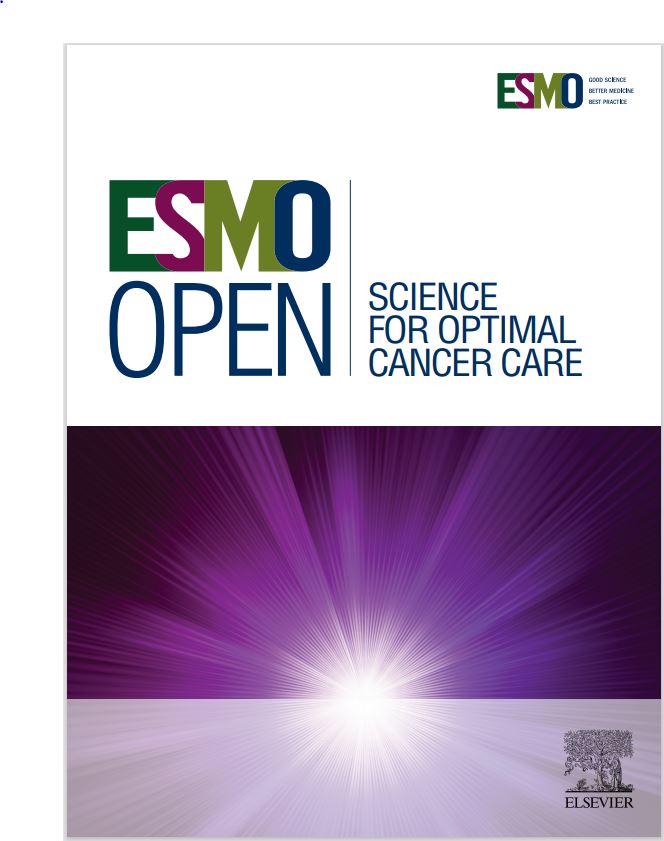意大利食管、食管胃交界和胃癌中PD-L1组织病理学工作流程和评估的重要见解。
IF 8.3
2区 医学
Q1 ONCOLOGY
引用次数: 0
摘要
背景:靶向程序性细胞死亡蛋白1/程序性死亡配体1 (PD-1/PD-L1)的免疫检查点抑制剂(ICIs)可提高局部晚期和转移性食管、食管胃交界和胃癌(GEC)的生存率。患者选择ici治疗依赖于通过免疫组化(IHC)评估PD-L1蛋白表达。本研究旨在比较PD-L1免疫组化结果与临床试验数据的真实评估。患者和方法:这项多中心、真实世界的回顾性研究分析了意大利28个病理中心2023年10月至2024年9月诊断的GEC病例的PD-L1 IHC数据。该研究通过联合阳性(CPS)、肿瘤比例(TPS)和肿瘤面积阳性(TAP)评分记录了PD-L1的表达分布,并研究了几个因素对IHC结果的影响。结果:我们收集了1936例:腺癌(ADCA) 1802例,鳞状癌(SCC) 131例,非特异性组织型癌3例。大多数机构报告了CPS和TPS数据,而少数机构使用了TAP。总体而言,CPS、TPS和TAP评分与ADCA和SCC的文献和临床试验数据一致,但观察到机构间异质性,以CPS≥1例ADCA为代表(机构间范围:43.6%-100%)。机构间异质性与几个变量显著相关,包括(i) PD-L1 IHC病例工作量,低工作量中心报告的平均CPS≥1例较多,以及(ii) PD-L1克隆,22C3克隆比SP263克隆显示更高的CPS评分。组织阻滞老化也与较低的PD-L1评分显著相关,关键时间窗为24-60个月。结论:本研究证实了意大利现实世界实践中GEC PD-L1表达与临床试验的一致性。机构间差异和分析前因素的显著影响,特别是组织老化和PD-L1克隆,突出了常规PD-L1检测的重要挑战。解决这些问题对于提高PD-L1 IHC评估的可靠性和确保GEC中ICIs的最佳患者选择至关重要。本文章由计算机程序翻译,如有差异,请以英文原文为准。
Critical insights on real-life PD-L1 histopathological workflow and assessment in esophageal, esophagogastric junction, and gastric carcinoma in Italy
Background
Immune checkpoint inhibitors (ICIs) targeting programmed cell death protein 1/programmed death-ligand 1 (PD-1/PD-L1) have improved survival in locally advanced and metastatic esophageal, esophagogastric junction, and gastric carcinoma (GEC). Patient selection for ICI-treatment relies on PD-L1 protein expression assessment via immunohistochemistry (IHC). This study aimed to evaluate the real-world assessment of PD-L1 IHC results compared with clinical trial data.
Patients and methods
This multicentric, real-world retrospective study analyzed PD-L1 IHC data from 28 Italian pathology centers of GEC cases diagnosed between October 2023 and September 2024. The study documented PD-L1 expression distribution via combined positive (CPS), tumor proportion (TPS), and tumor area positivity (TAP) scores, and investigated the impact of several factors on IHC results.
Results
We collected 1936 cases: 1802 adenocarcinomas (ADCA), 131 squamous carcinomas (SCC), and 3 carcinomas of non-specific histotype. Most institutions reported CPS and TPS data, whereas a minority used TAP. Overall, CPS, TPS, and TAP scores were in line with the data in literature and clinical trials for both ADCA and SCC, but inter-institutional heterogeneity was observed as represented by CPS ≥1 ADCA cases (range among institutions: 43.6%-100%). Inter-institutional heterogeneity was significantly associated with several variables, including (i) PD-L1 IHC case workload, with lower workload centers reporting more CPS ≥1 cases on average, and (ii) PD-L1 clone, with the 22C3 clone showing higher CPS scores than the SP263 clone. Tissue block aging was also significantly associated with a lower PD-L1 score, with a critical time window at 24-60 months.
Conclusions
This study confirms the alignment of GEC PD-L1 expression in Italian real-world practice with clinical trials. Inter-institutional variability and the significant influence of preanalytical factors, particularly tissue aging and PD-L1 clone, highlight important challenges in routine PD-L1 testing. Addressing these issues is crucial to enhance the reliability of PD-L1 IHC assessment and ensure optimal patient selection for ICIs in GEC.
求助全文
通过发布文献求助,成功后即可免费获取论文全文。
去求助
来源期刊

ESMO Open
Medicine-Oncology
CiteScore
11.70
自引率
2.70%
发文量
255
审稿时长
10 weeks
期刊介绍:
ESMO Open is the online-only, open access journal of the European Society for Medical Oncology (ESMO). It is a peer-reviewed publication dedicated to sharing high-quality medical research and educational materials from various fields of oncology. The journal specifically focuses on showcasing innovative clinical and translational cancer research.
ESMO Open aims to publish a wide range of research articles covering all aspects of oncology, including experimental studies, translational research, diagnostic advancements, and therapeutic approaches. The content of the journal includes original research articles, insightful reviews, thought-provoking editorials, and correspondence. Moreover, the journal warmly welcomes the submission of phase I trials and meta-analyses. It also showcases reviews from significant ESMO conferences and meetings, as well as publishes important position statements on behalf of ESMO.
Overall, ESMO Open offers a platform for scientists, clinicians, and researchers in the field of oncology to share their valuable insights and contribute to advancing the understanding and treatment of cancer. The journal serves as a source of up-to-date information and fosters collaboration within the oncology community.
 求助内容:
求助内容: 应助结果提醒方式:
应助结果提醒方式:


